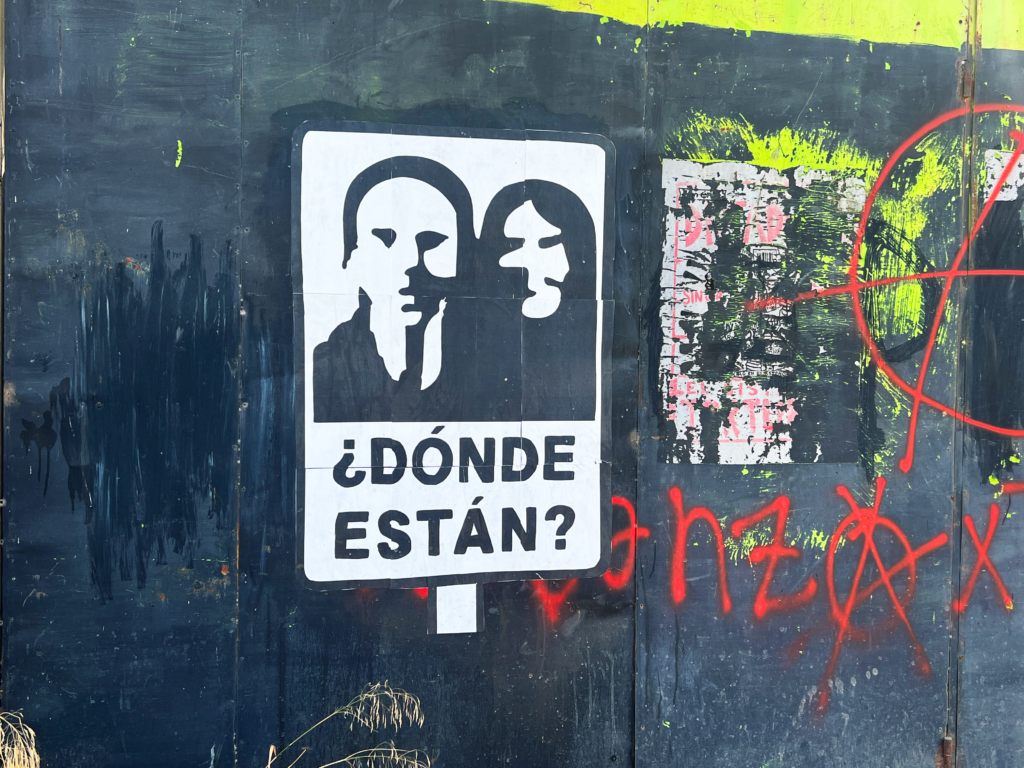 Photo Essay
Photo Essay
Uncovering Chile’s Largest Mass Grave
Marc Cooper / Truthdig September 11, 2023 The Pinochet dictatorship buried its first victims in a notorious patch of dirt called Patio 29. 8 photos-

Patio 29 is the largest mass grave found to date from the Pinochet dictatorship of 1973 – 1990. Rumors of its existence within Santiago’s General Cemetery were confirmed when church-affiliated human rights workers in 1979 uncovered 109 unmarked graves. Most crosses bore the simple inscription “N.N.” (No Name.) It is believed that at least 125 bodies were secretly disposed of here by the dictatorship. Most of the victims were from the earliest months of the military government. Despite a judicial order in 1981 that no bodies from this site be moved or exhumed, there are numerous and unconfirmed reports that a year later, the military surreptitiously dug up and moved hundreds of bodies. The official count, however, is 126 bodies, crammed into 105 crypts, a fact that Pinochet applauded publicly as one of great “economy.” The bodies were all exhumed when democratic rule returned, but most were not identifiable. Many appeared to have been beaten and tortured prior to execution and were missing limbs and other body parts. To date, after 30 years of slap-dash investigation by the state, only about half the victims have been identified. (Photo by Marc Cooper)
-

Those dumped and buried in Patio 29 were but a small fraction of the more than 1,400 Chileans “disappeared” by the dictatorship. Of those, only about 300 have been identified. The whereabouts of the majority of victims remain unknown, and the relevant military and police records remain sealed. (Photo by Marc Cooper)
-

Long-time political activist Antonio “Toño” Kadima, a former political prisoner and survivor of torture, leads a volunteer group the first Saturday of every month to tidy up the site, clean away rubbish and provide new vases for flowers. “We started coming three years ago,” he said. “This sacred place had been pretty much abandoned and left to decay. We are not going to let that happen.” (Photo by Marc Cooper)
-

Most of the volunteers are relatives or friends of the victims. (Photo by Marc Cooper)
-

Among the volunteers on this Saturday is 50-year-old Jorge Saez Jr. His father, Jorge Sr., was taken by uniformed police on the evening of Oct. 19, 1973, while on his way home. At the time, Jorge Sr. was 23 and had a young wife and a young daughter. The morning of his disappearance, he learned he was to be a father for the second time. When he failed to return home that night, his wife Isabel began the search by going to local police stations. At one commissary, she was told that her husband had been detained and executed that same night. No further information was offered then or thereafter as to Jorge or his demise. But the family, like many of the relatives of the disappeared, continued a relentless, frustrating and generally fruitless search. “He never represented a threat to anyone and we have never found the reason he was taken,” says his daughter-in-law Maria. (Photo by Marc Cooper)
-

On Dec. 5, 2006, Jorge Jr. and his family finally learned of the final resting place when the Medical Legal Institute positively matched DNA identifying Jorge Sr. as one of the Patio 29 victims. His family interred his remains to a proper grave bearing his name. “The tyrants tried to extinguish his surname,” says Maria. “But today there are adult children and grandchildren who proudly carry the name Saez and who honor the young gardener who the dictatorship murdered and disappeared.” (Photo by Marc Cooper)
-

In July of 2006, Patio 29 was declared a National Historic Monument and an official Site of Memory. It’s commemorative plaque describes Patio 29 as ”an emblematic place of the human rights violations that took place between 1973 and 1990 as it was used to cover up the bodies and identities of the detained disappeared and politically executed during the military regime.” The plaque vows that such grotesque violations of human rights will occur “Never Again.” (Photo by Marc Cooper)
-

On Aug. 30 of this year, Chile’s leftist President Gabriel Boric announced a long-promised National Search Plan to identify the still more than 1,000 Chileans who remain “disappeared” and unaccounted for. The plan will begin with the assembly of a master database of all those missing. In announcing the plan, his minister of justice conceded that for the last 33 years of civilian rule succeeding governments have not done all they could to find the missing and that this task was put mostly on the shoulders of the surviving relatives. ‘The state was responsible for their disappearance,” said Minister Luis Cordero. “It’s time now for the state to assume the responsibility of finding them.” (Photo by Esteban Felix/AP Photo)

